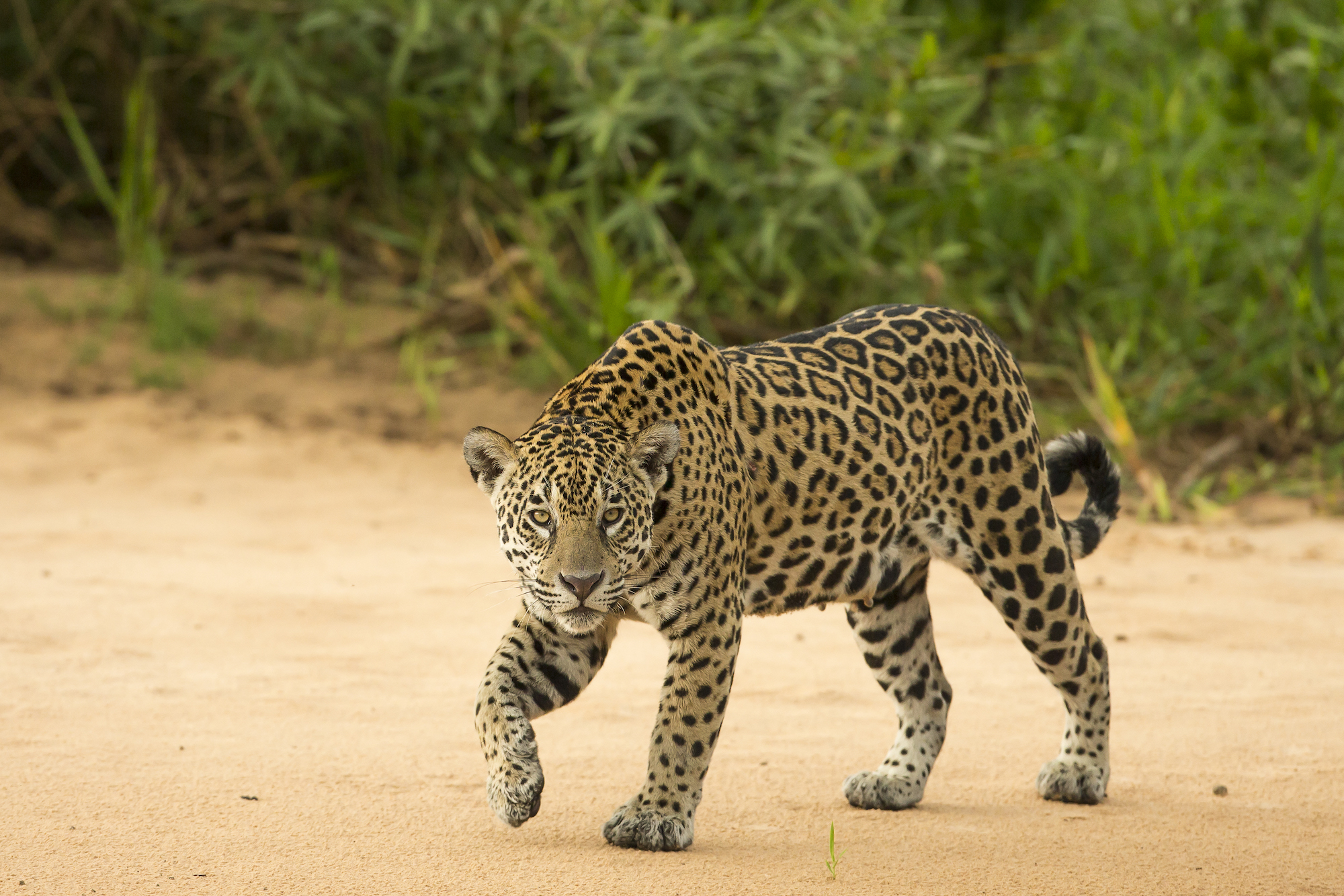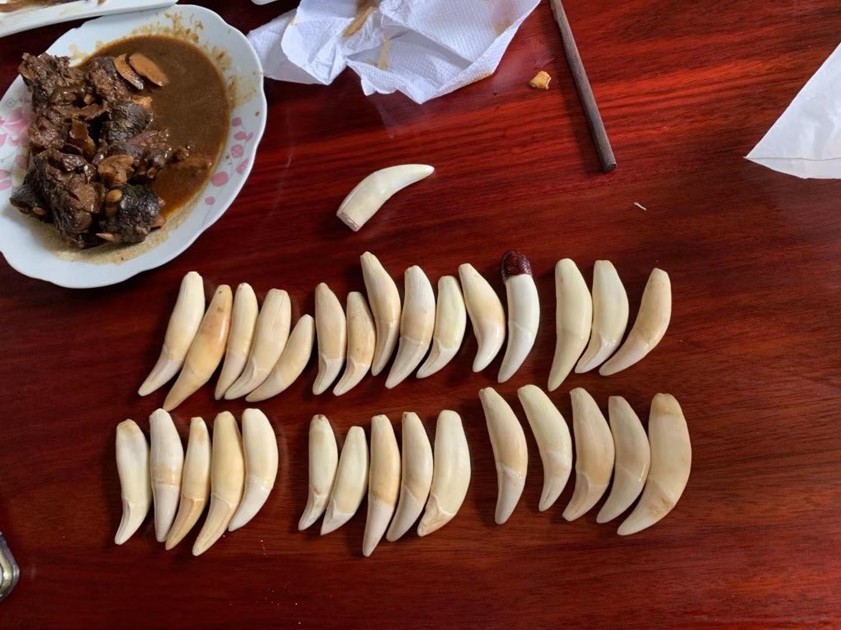- The findings of an investigation called “Operation Jaguar” shed light on the connections between the illegal trafficking of jaguar parts and other crimes, like human trafficking, drug trafficking, money laundering and illegal mining.
- The investigation also revealed how the illegal trade of jaguars has been integrated into international organized crime by involving several routes from Suriname to China.
- The investigation team recommends that authorities from different domains and different ministries support each other and work together to tackle this “convergence of crimes.”
Experts on wildlife crime in Suriname monitored and documented two of the most powerful jaguar trafficking networks in South America. The networks, called “SA1” and “SA18,” operate in Suriname and are directed by overseers from China. The investigation provided detailed information on both networks, their trafficking routes, their operational methods, and details on the convergence of this trafficking with other serious crimes, including human trafficking, illegal mining and money laundering.
“The most important message for law enforcement officials, governments and other non-governmental organizations is [that they should] treat jaguar trafficking not just as a simple crime against wildlife, but as a crime that is in the hands of dangerous people who are also involved in other serious crimes; we want to lift the level of the conservation practices to explain that this is more serious than opportunistic jaguar hunting,” said Andrea Crosta, the founder and director of Earth League International (ELI), an NGO that fights environmental and wildlife crimes through research, analysis and intellect.
ELI joins the National Committee of The Netherlands within the International Union for Conservation of Nature (IUCN), which leads Operation Jaguar. This operation is a collaborative project with the International Fund for Animal Welfare (IFAW), with support from the Dutch Lottery.

The illegal trafficking of jaguar fangs, bones and other body parts puts these big cats at risk and is an extremely profitable business in Latin America. Throughout the region, jaguars (Panthera onca) are severely threatened by poaching and illegal trafficking. Although the species is protected in Suriname by the Hunting Decree 2002 and by the Convention on International Trade in Endangered Species of Wild Fauna and Flora (CITES), there is evidence of an escalation in jaguar hunting in the past few years. This has contributed to a decrease in their population.
Since 2019, experts from ELI have been dedicated to mapping the mechanisms and structure of the entire criminal chain involved in the jaguar trafficking industry, from the highest link — which includes the leaders of the networks — to the traders, transporters and sellers. With this information, these experts have published several preliminary reports to explain the dynamics of these crimes in four Latin American countries: Ecuador, Peru, Bolivia and Suriname. In March 2023, they published a final report on their research.

Illegal mining and jaguar parts trafficking
Since the beginning of their work in the region, scientists from ELI have managed to identify more than 20 people in Suriname involved in the trade of jaguar parts. Of them, 14 were Chinese citizens and the rest were Surinamese or European. All of them are considered to be “Level One” international traffickers, according to the investigation. The investigation provides evidence of two of South America’s strongest and most evolved wildlife trafficking networks. The investigation found there are many more traffickers involved than was once believed, and they operate and collaborate through multiple networks in Latin America.
“These networks operate on a cross-border and international level; we said this from the beginning, but now there is evidence,” said Liliana Jauregui, a specialist in environmental justice cases for the IUCN National Committee of The Netherlands and leader of the Operation Jaguar project. “This presents challenges because these types of crimes are more complex than what the authorities can handle; in addition, people lower on the ‘crime chain’ are always attacked, and if they really want to stop the problem, they must take action higher up on the chain,” said Jauregui.

For example, the investigation team revealed that illegal mining maintains an important relationship with the jaguar trafficking industry. The specialists discovered that some gold miners have been recruited to kill jaguars in areas close to the border with Brazil. Members of the SA18 criminal network visit these mining sites once a year, while members of the SA1 criminal network also hunt jaguars in a town called Apoera, which is close to the border with Guyana, where one of the traffickers’ collaborators operates a timber factory.
“Mining and the jaguar [trafficking industry] are both pretty lucrative. If you compare how dangerous mining is [to the jaguar industry], the jaguar [industry] is much less so. These people make practical choices; it is not very strange that they combine the two things. They are in the same space and the animals are ‘in the way.’ By killing them, they can earn more money,” said Jauregui.
Sources collaborating with ELI said that Chinese buyers often arrive at a hunting site by helicopter or boat and then drive off-road vehicles to a gold mining site in the mountains. When this occurs, jaguar products become more expensive once they reach buyers in Paramaribo, the capital of Suriname, and are worth equal to — or more than — gold when sold in China.

It was also confirmed that the transport of jaguar products from Suriname to Asia occurs via the Netherlands and, to a lesser extent, via the United States. To achieve this, according to specialists, the criminals take advantage of gaps in the system. For example, ELI’s investigations into SA18 identified a few traders who have a wide availability of jaguar fangs and shark fins in Suriname’s capital. One of them works in the customs clearance department to ensure that containers of illegal wildlife products arriving from China are not identified.
“There is a source that even says that one can get through Schiphol Airport, which is the [main] Dutch airport, with the goods; this shows that there is a structure that facilitates this,” said Jauregui.
The convergence of crimes
The ELI team suggested that the traditional law enforcement approaches that focus on isolated illegal businesses in Suriname — and in other countries where jaguar trafficking also occurs, like Ecuador, Peru and Bolivia — are no longer suitable for understanding and addressing the complexities of organized crime. For these criminals, the trafficking of jaguars is only a business and is not a different crime than the others that they already commit. For that reason, experts refer to this as a “convergence of crimes,” because in the end, they all converge in the same hands.
The problems surrounding the fight against illegal jaguar trafficking do not lie in the involved countries’ laws — since they are well-written and well-defined — but in their enforcement and in the weak investigative abilities of the authorities.

When discussing this convergence of crimes, it makes sense to involve other law enforcement agencies that do not normally investigate wildlife crimes. Exclusively collaborating with different ministries of the environment — which can often do very little by themselves — could lead them to the same suspects involved in related crimes. It was found that not only do the traffickers commit wildlife crimes and traffic parts from other species, like shark fins, turtles and seahorses, but also that, in the case of Suriname, these networks launder about $500,000 per day, operate legal businesses as fronts and have visas to enter and exit the United States.
Authorities who do not take action
The specialists who carried out the investigation explained that, so far, it’s been possible to deliver only the public data and some additional details to Surinamese authorities. Because this is sensitive, detailed information — which may put people at risk — it requires a specialized type of meeting, which has not yet taken place.
“A previous report was delivered at the CITES conference that was related to the convergence of crimes, and it is the same information; even some quotes [from sources] are shared. That information was delivered hand-to-hand [to environmental authorities from Suriname]. However, so far, we have not had the chance to submit the other information, because that requires a different type of process, more political and more diplomatic; the country has other priorities at the moment,” said Jauregui.

In general, researchers from ELI have encountered this problem in the countries they have investigated. However, in Suriname in particular, it has been difficult to identify the people involved and the correct ways to take action. So far, no arrests have been made.
“There are many problems and we don’t want to give confidential information about powerful people to someone corrupt, or to someone who is honest but has no power and can’t do anything about it. Sooner or later, the information might reach the criminals,” said Marc Hoogeslag, the coordinator of the land acquisition fund and an official from Operation Jaguar.

Recommendations to stop illegal trafficking
The public document provided several detailed recommendations to the Surinamese government. One recommendation is that sufficient financial and human resources should be invested. “That is very easy to say, but at the same time, we are also telling international authorities and potential international funders that the government of Suriname needs support for this,” said Jauregui.
Crosta, the founder and director of ELI, insisted that trafficking and poaching are threats to the jaguar’s long-term survival. He said that jaguar body parts are sold as tiger parts in China, and added that 100 years ago, there were 100,000 tigers in the wild and there are now fewer than 4,000. “We do not want what happened to the tiger to happen to the jaguar,” said Crosta.
The situation is extremely dire throughout the continent, according to Jauregui. “Many things are happening at the same time. While you have abundant biodiversity, with many species that are emblematic and valuable, there are plans for development and investment, but almost no law enforcement for this type of crime, with very minor penalties. There is little interest; the priority is low. All of this, together, is what I call the perfect storm,” said Jauregui.

Banner image: The skull of a jaguar (Panthera onca). Image by Britta Jaschinski for IUCN Netherlands.
This story was reported by Mongabay’s Latam team and first published here on our Latam site on May 9, 2023.
See related coverage here at Mongabay:
Years of pioneering work make Brazil the model for reintroduction of jaguars














